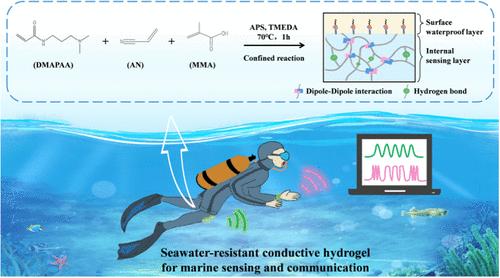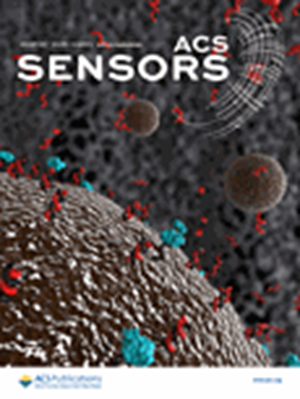Skin-like Heterogeneous and Self-Healing Conductive Hydrogel toward Ultrasensitive Marine Sensing
IF 8.2
1区 化学
Q1 CHEMISTRY, ANALYTICAL
引用次数: 0
Abstract
Flexible wearable electronic devices based on hydrophobic, conductive hydrogels have attracted widespread attention in the field of underwater sensing. However, traditional homogeneous hydrogels tend to compromise their conductivity and sensing performance when achieving hydrophobicity, and the high complexity of marine environments further reduces their sensing performance and service life. Here, we develop a seawater-resistant conductive hydrogel with ultrahigh sensitivity and self-healing ability by the introduction of a skin-like heterogeneous structure, consisting of a hydrophobic outer layer that protects against seawater and a conductive internal layer that senses. Based on a heterogeneous structure obtained through surface hydrophobic modification of confined nitrogen-alkylation reaction, the conductive hydrogel simultaneously achieves satisfying seawater resistance (contact angle of 123.2°), high ionic conductivity (2.86 S m–1), and excellent sensing sensitivity in seawater (GF = 6.15), harmonizing the contradiction between water resistance and sensing of traditional hydrophobic hydrogels. In addition, abundant hydrogen-bonding and dipole–dipole interactions endow the heterogeneous hydrogel with an outstanding self-healing ability, exhibiting high-efficiency self-healing behavior in seawater. Underwater strain sensors constructed with the heterogeneous hydrogel can be used for detecting human motion in simulated seawater environments and real-time signal transmission, showcasing their great potential as wearable electronic devices in the marine sensing field.

面向超灵敏海洋传感的类皮肤异质自愈导电水凝胶
基于疏水导电水凝胶的柔性可穿戴电子器件在水下传感领域引起了广泛关注。然而,传统的均相水凝胶在实现疏水性的同时往往会降低其导电性和传感性能,而海洋环境的高度复杂性进一步降低了其传感性能和使用寿命。在这里,我们开发了一种具有超高灵敏度和自愈能力的耐海水导电水凝胶,通过引入一种类似皮肤的异质结构,包括一个疏水的外层,保护海水和一个导电的内层,感知。该导电水凝胶基于封闭氮-烷基化反应表面疏水改性获得的非均相结构,同时实现了令人满意的耐海水性(接触角123.2°)、高离子电导率(2.86 S m-1)和优异的海水传感灵敏度(GF = 6.15),协调了传统疏水水凝胶的耐水性与传感性之间的矛盾。此外,丰富的氢键和偶极子-偶极子相互作用使非均相水凝胶具有出色的自愈能力,在海水中表现出高效的自愈行为。利用非均相水凝胶构建的水下应变传感器可用于模拟海水环境下的人体运动检测和实时信号传输,作为海洋传感领域的可穿戴电子设备具有巨大的潜力。
本文章由计算机程序翻译,如有差异,请以英文原文为准。
求助全文
约1分钟内获得全文
求助全文
来源期刊

ACS Sensors
Chemical Engineering-Bioengineering
CiteScore
14.50
自引率
3.40%
发文量
372
期刊介绍:
ACS Sensors is a peer-reviewed research journal that focuses on the dissemination of new and original knowledge in the field of sensor science, particularly those that selectively sense chemical or biological species or processes. The journal covers a broad range of topics, including but not limited to biosensors, chemical sensors, gas sensors, intracellular sensors, single molecule sensors, cell chips, and microfluidic devices. It aims to publish articles that address conceptual advances in sensing technology applicable to various types of analytes or application papers that report on the use of existing sensing concepts in new ways or for new analytes.
 求助内容:
求助内容: 应助结果提醒方式:
应助结果提醒方式:


